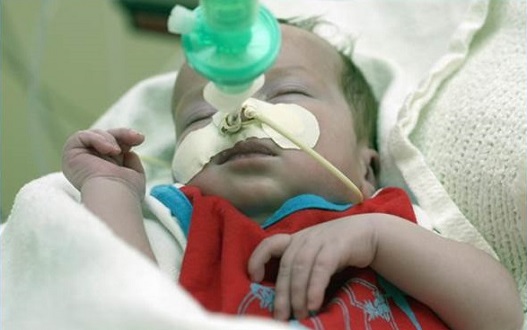Respiratory syncytial virus (RSV) is a major cause of childhood mortality and morbidity. RSV infection is the second most frequent cause of death during infancy. Most children were previously healthy until infected.
Virtually all children dying from RSV infection live in developing countries. RSV-related morbidity is substantial in all parts of the world. Although all children are infected with RSV during the first two years of life, about 1% of all children in the world will be hospitalized for RSV infection in the first year of life.
Bronchiolitis is the typical syndrome associated with RSV infection, which consists of a runny nose, coughing and wheezing. Among children admitted for RSV infection, about 10% will require mechanical ventilation at an intensive care unit to survive. In parts of the world where intensive care units are absent, these children do not survive the infection. Some pre-existent diseases are related to increased risk of severe RSV infection, such as prematurity, congenital heart disease and Down syndrome. RSV infection has a strong seasonality in most parts of the world. In the Netherlands, RSV infection peaks in the middle of the winter and is fully absent from April/May until September/October.
RSV infection is associated with long-term airway disease. About half of the children with a history of RSV infection will have asthma-like symptoms. There is evidence that even emphysema and chronic obstructive pulmonary disease (COPD) occurs more frequently among people with a history of RSV infection during infancy. RSV infection is also more severe in older adults, in particular those with severe other diseases. In those people, the burden is similar to what is seen with influenza infection.
An interdisciplinary approach is needed to understand and treat children infected with RSV infection. In the Utrecht RSV Research Group various disciplines are positioned around the patient and their parents. Various medical specialists are involved in these teams, including obstetricians, neonatologists, pulmonologists, intensive care specialists, radiologists and infectious diseases specialists. Nurses play a major role in treating children with RSV infection as they are most often at the bedsite and are closest to the parents. Research nurse have always been the corner stone of our clinical research. Basic scientists with different background are involved in our research. Together with immunologists we try to understand whether children get sick directly from airway damage cause by the virus or the immune response to infection (“fire vs fire controle damage”). Together with virologists we study the gene of RSV in detail hoping to understand how the virus infects baby’s and tries to escape the immune system, but also to understand how a treatment or vaccine may be developed. Epidemiologists and more basic modeling specialist play a key role in all parts of the research work. The research group has a strong interest in Global Health with relevant collaborations with the World Health Organization (WHO), the Bill and Melinda Gates Foundation (BMGF), the European Center of Disease Control (ECDC), the National Institute of Health (NIH) of the United States and various pharmaceutical companies.
Children with a history of RSV infection appear to develop normal although recurrent episodes of wheeze is associated with decreased health of life in specific domains. Mental development is normal.
There is strong involvement of patients in the RSV Research Group. Nicole Derksen is employed by the UMCU as the chairperson of the Dutch Patient Advisory Board (PAB) and the EU PAB for RSV infection. The Dutch PAB is involved in all parts of the research, including prioritizing research questions, drafting grant applications, writing patient information and communicating with various stakeholders.
Related links
